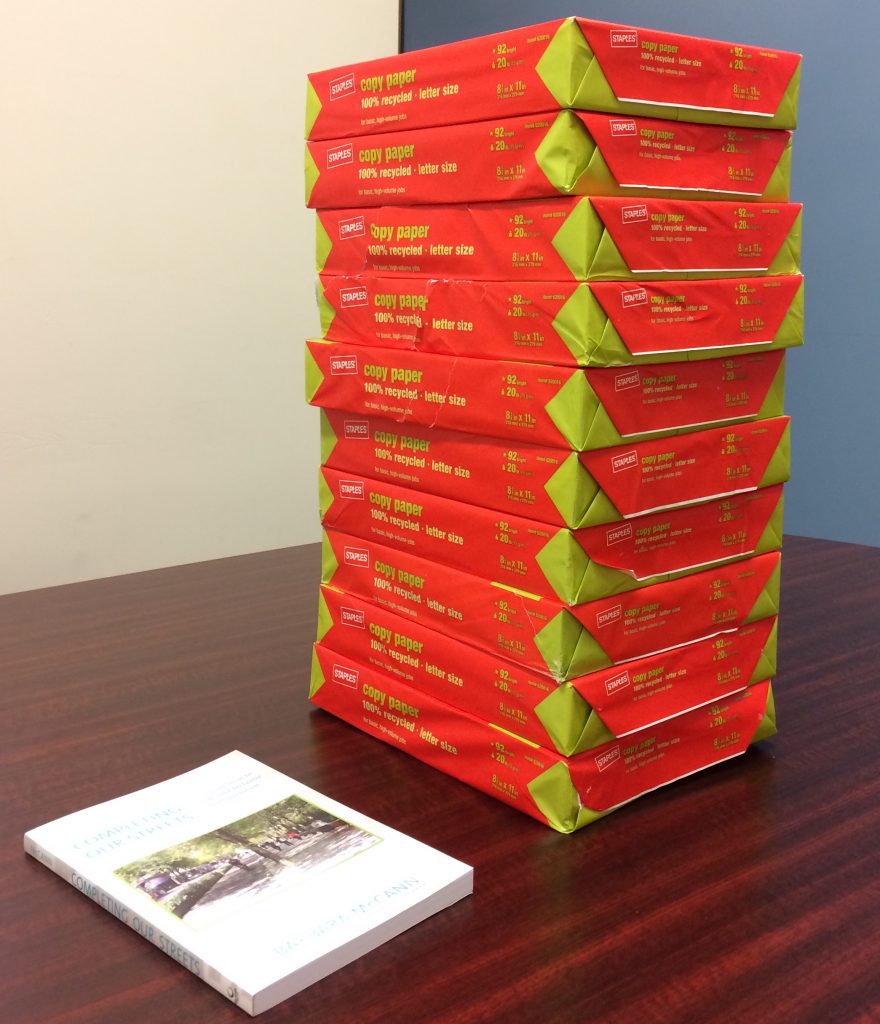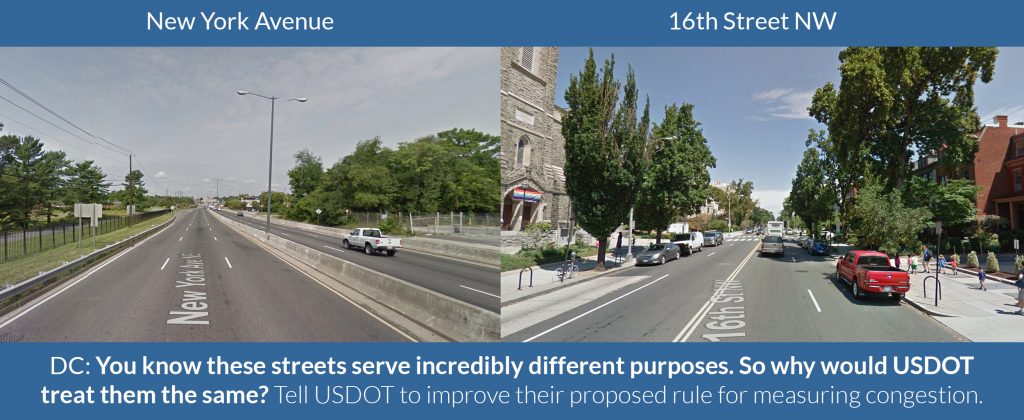USDOT faces widespread opposition to proposed congestion rule
Nearly 5,000 individuals and 150 organizations — including dozens of local chambers of commerce and elected officials — joined with T4America to oppose USDOT’s flawed proposal for measuring traffic congestion and urge them to rethink their approach.

Since USDOT allows digital submissions and we didn’t have to waste any paper for your letters, here’s what 5,000 pieces of copy paper looks like next to a terrific book about Complete Streets for scale.
Almost 5,000 of our supporters sent letters urging USDOT to rewrite the department’s new requirements for measuring (and addressing) congestion — requirements that, as written, would induce sprawl, harm the economic potential of our main streets by treating them like highways, punish cities investing in public transportation, completely ignore people walking, biking, carpooling or telecommuting, and push local communities of all sizes to waste billions of dollars in vain attempts to build their way out of congestion.
“There’s a direct connection between how we measure congestion and the ‘solutions’ that we invest in,” said James Corless, director of Transportation for America, in our full press release yesterday. “And by prioritizing vehicles over people and completely ignoring a diversity of transportation options, this proposed rule would fail the communities that our transportation investments are intended to serve.”
USDOT has been undertaking a welcome and necessary shift toward measuring what our federal transportation spending actually accomplishes by establishing a new system of performance measures to hold states and metro areas accountable for making progress on important goals.
We know these rules sometimes seem arcane or obtuse, so we explained a real-world example of how they could play out in this opinion piece for The Hill last week:
The measure would fail to reward places that use existing streets more efficiently — particularly in urban areas where space is at a premium.
Take for example the 16th Street NW corridor in Washington DC. The street is often clogged at rush hour but, since it’s in the middle of the city, it can’t be widened. So how should transportation engineers address the congestion? One solution would be to add priority lanes for buses, which already carry more than half of all rush hour trips along the corridor. Prioritizing 50-passenger buses over single-occupancy cars would vastly increase the carrying capacity of the street and allow it to move even more people per hour than it does today. But under the Department of Transportation’s proposed rule, if this strategy succeeded in moving more people but had an even slightly negative impact on average travel speed per vehicle, it would get low marks.

Part of the 16th street corridor in question, referenced in the above op-ed, is at right in the above graphic. During rush hour, buses carry more than half of all trips taken on this corridor.
That’s just one example, but in case you haven’t been following along recently, we’ve outlined the scope of the rule’s problems several times over the 120 days of the comment period, which closed on Saturday, August 20th.
In addition to the nearly 5,000 letters we delivered to USDOT last Friday night, an impressive and diverse coalition of business groups, local elected leaders and national and local organizations also signed a single letter proposing concrete ways for USDOT to fix the rule. Over the last four months, we convened more than 30 local elected officials, state DOTs, metropolitan planning organizations (MPOs) and transit agencies, national and state trade groups and advocacy organizations to develop a better measure to recommend to USDOT that has buy-in from practitioners on the ground.
The first recommendation in that letter is a simple one that gets to the heart of what needs to be fixed: “Travel time/delay is felt by the people who travel, not by the vehicle, and U.S. DOT should propose a measure that focuses on people and not vehicles.”
21 chambers of commerce from across the country also signed a separate letter signaling their concerns about a measure that would punish cities and regions investing in public transportation and walkable downtowns to stay economically competitive:
The proposed rule focuses on vehicle speeds only, which discourages local decision-makers from investing in transit, pedestrian, and bicycle infrastructure and impedes progress towards the walkable, accessible, and vibrant business districts that we are striving to achieve. A comprehensive mix of strategic transportation investments is necessary to allow American businesses to remain competitive. Hundreds of companies across the United States are moving to and investing in walkable downtown and business district locations. Companies want their location to be accessible by a range of transportation options in order to attract and retain talented workers. Performance measures included in this rule should account for all modes of transportation to both capture and encourage important investments that support resilient, strong local economies.
USDOT Secretary Anthony Foxx has embarked upon an ambitious effort to repair the damage of poorly-planned highway projects that divide communities and ensure that future transportation investments do a better job of connecting all people to economic opportunity — especially low-income communities and communities of color. Advancing a proposal that would prioritize high traffic speeds at all times of day on all types of roads would undermine the Secretary’s own efforts.
We are hopeful that USDOT will heed this call and change the rule to count everyone and support the local, metro and state leaders planning ambitious, smart transportation investments to better connect all people to opportunity.




















Pingback: Today’s Headlines | Streetsblog St. Louis
Pingback: USDOT faces widespread opposition to proposed congestion rule | Smart Growth America
Pingback: Engineers to U.S. DOT: Transportation Is About More Than Moving Cars | Streetsblog USA